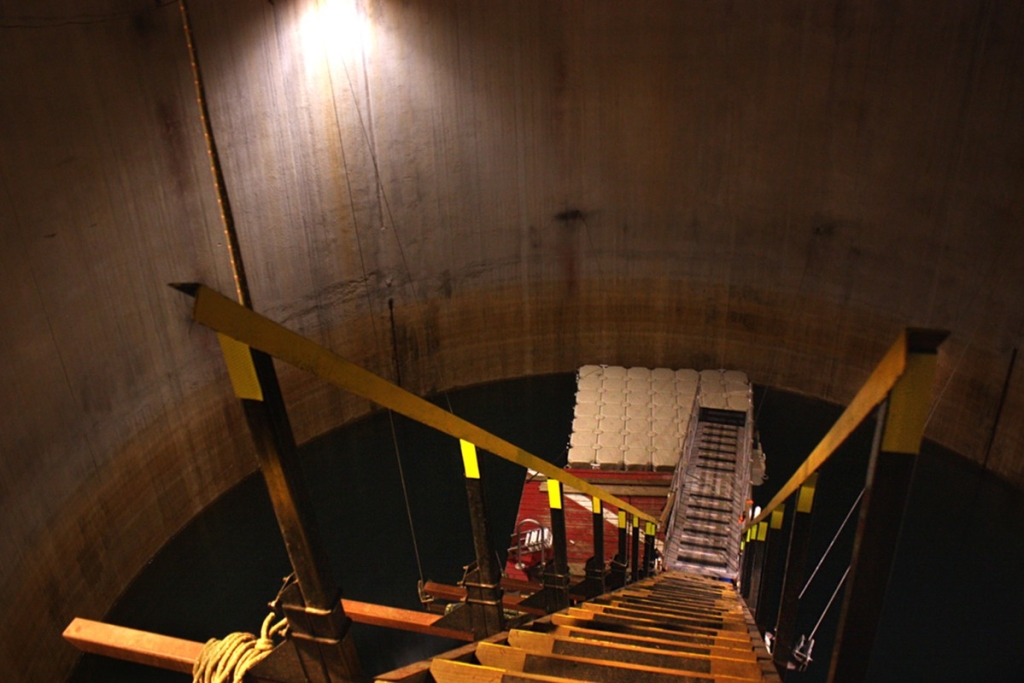Divers Plunge Into History–in a Flooded Missile Silo
By Andrew East
For Reporting Texas
Although the days of mutually assured destruction are over, Texans can still dive into their state’s Cold War past. Dive Valhalla, located just outside Abilene, offers patrons the chance to scuba dive in a decommissioned nuclear missile silo.
Built in 1962, the silo once housed a 75-foot-tall Atlas F intercontinental ballistic missile pointed at the Soviet Union. The military decommissioned the silo in 1965 and removed the 270,000-pound thermonuclear missile. Over the past 49 years, 130 feet of groundwater has flooded the silo, said co-owner Mark Hannifin of Midland-based Family Scuba Center Inc.
“I’ll bet you that 95 percent of people in Texas don’t even know [these silos] exist, and when they do, they’re kind of curious about them,” he said. “This is one way to get in and see one without getting shot at.”
As technology advanced during the mid-1960s, the U.S. military began decommissioning Atlas missile silos and selling them to the highest bidder. There are 12 Atlas silos in the Abilene area and 72 nationwide. Several ended up in the hands of civilians, who converted them into a wide array of uses, including houses, schools and, in Hannifin’s case, a scuba diving facility.
Though Hannifin declined to reveal how much he paid for the silo, Ed Peden, founder of Kansas-based 20th Century Castles, has sold 57 decommissioned military structures over the past 20 years, including three nuclear missile silos in Texas. He said in the mid-1980s, missile silos typically sold for $40,000 to $80,000.
“They’re getting more expensive rapidly,” he said. “Now it’s hard to find anything under $200,000.”
John McAlpin, leader of the dive club at Austin-based Tom’s Dive and Swim, dove in the silo last year. He said the water is clear and about 60 degrees year round. If you dive deep enough, you can find debris left behind by salvagers looking to sell its excess steel, McAlpin said.
“Some of the stuff they pulled out gave way and fell,” he said. “So there is quite a bit of rubble down around 110 feet that you can look around in. There are doors with portholes in them and beams.”
Hannifin, who purchased the silo in 1982 with the idea of converting it into a survivalist shelter, was in the process of selling it in 1992 when he consulted with his scuba instructor about diving into the water.
“We weren’t getting out there much,” said Hannifin. “So we said, ‘We’ll sell it and see if there’s some other moron out there who will buy it.’ But before we sold it, I wanted to dive in the water.”
Hannifin said his scuba instructor persuaded him to charge people to dive. Now about 150 to 200 people dive in the silo each year. Dives cost from $60 to $140 and are booked in groups.
Hannifin is building a bed and breakfast in an underground room attached to the silo for survivalists who are not sure if they want to live underground. Survivalists prepare to withstand catastrophic events through training in self-defense, stashing food and constructing self-sufficient shelters.
The bed and breakfast is slated to open by mid-2015. A stay will cost around $100 a night for one of six double beds and a menu of freeze-dried food.
“I figure if somebody is down there for 48 hours, they can make a better judgment call about whether you want to build that cargo container in your backyard or not,” said Hannifin. “You might want to poll the family and make sure you want to do this rather than going ahead and building it and find out, ‘I ain’t going in that damn thing.’”
Although the silo belongs to a bygone era, it continues to attract visitors.
“It’s not for sale anymore, but we’re still diving in it,” said Hannifin.

